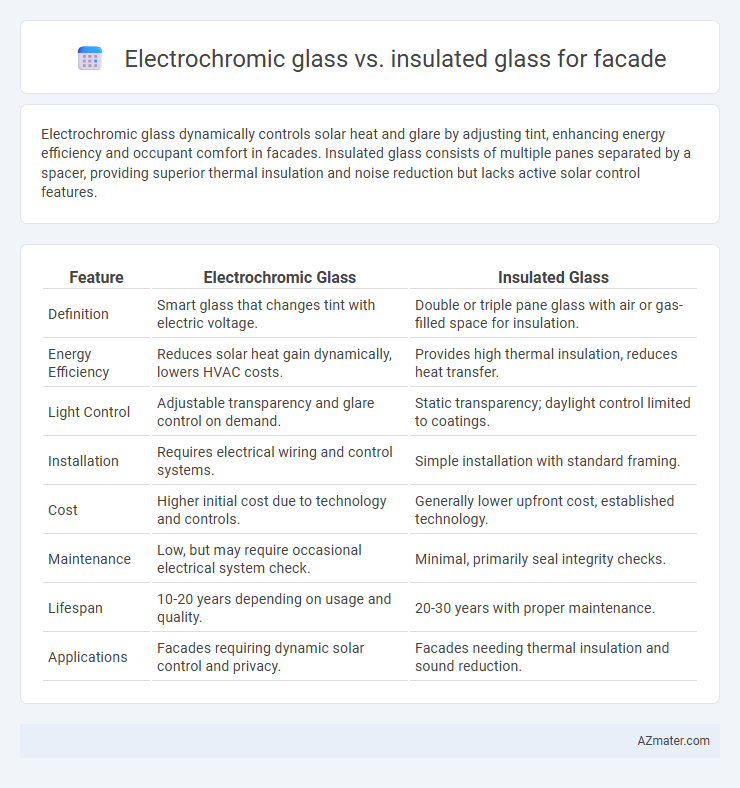Electrochromic glass dynamically controls solar heat and glare by adjusting tint, enhancing energy efficiency and occupant comfort in facades. Insulated glass consists of multiple panes separated by a spacer, providing superior thermal insulation and noise reduction but lacks active solar control features.
Table of Comparison
| Feature | Electrochromic Glass | Insulated Glass |
|---|---|---|
| Definition | Smart glass that changes tint with electric voltage. | Double or triple pane glass with air or gas-filled space for insulation. |
| Energy Efficiency | Reduces solar heat gain dynamically, lowers HVAC costs. | Provides high thermal insulation, reduces heat transfer. |
| Light Control | Adjustable transparency and glare control on demand. | Static transparency; daylight control limited to coatings. |
| Installation | Requires electrical wiring and control systems. | Simple installation with standard framing. |
| Cost | Higher initial cost due to technology and controls. | Generally lower upfront cost, established technology. |
| Maintenance | Low, but may require occasional electrical system check. | Minimal, primarily seal integrity checks. |
| Lifespan | 10-20 years depending on usage and quality. | 20-30 years with proper maintenance. |
| Applications | Facades requiring dynamic solar control and privacy. | Facades needing thermal insulation and sound reduction. |
Introduction to Facade Glass Technologies
Electrochromic glass offers dynamic solar control by adjusting its tint in response to electrical signals, enhancing energy efficiency and occupant comfort in building facades. Insulated glass consists of two or more glass panes separated by a sealed air or gas-filled space, providing superior thermal insulation and noise reduction. Both technologies play pivotal roles in modern facade design, balancing energy performance with aesthetic appeal.
What is Electrochromic Glass?
Electrochromic glass is a dynamic glazing technology that changes its tint in response to electrical signals, enabling precise control over solar heat and glare while enhancing energy efficiency in building facades. Unlike insulated glass, which primarily offers thermal insulation through its multi-pane design, electrochromic glass actively modulates light transmission to reduce cooling loads and improve occupant comfort. This smart glass technology integrates advanced materials such as transition metal oxides, allowing facades to switch from transparent to tinted states on demand.
What is Insulated Glass?
Insulated glass consists of two or more glass panes separated by a spacer filled with air or inert gas, designed to improve thermal performance and reduce heat transfer in facades. Unlike electrochromic glass that actively controls light and heat transmission through electrical tinting, insulated glass provides passive energy efficiency by enhancing insulation and soundproofing. Its primary function in building facades is to maintain indoor temperature stability and increase energy savings without dynamic adjustment capabilities.
Comparative Energy Efficiency
Electrochromic glass dynamically adjusts its tint to control solar heat gain, significantly reducing cooling loads and enhancing energy efficiency compared to traditional insulated glass, which relies solely on fixed thermal insulation properties. Studies show electrochromic facades can lower building energy consumption by up to 20-30% through real-time solar modulation, whereas insulated glass primarily improves energy retention and reduces heat loss. The integration of electrochromic technology offers superior adaptive energy performance, making it a more efficient solution for climates with variable solar exposure.
Light Control and Glare Reduction
Electrochromic glass offers dynamic light control by electronically tinting to adjust transparency, significantly reducing glare and solar heat gain in real-time. Insulated glass, with its fixed double or triple-pane design, provides effective thermal insulation but lacks adaptive light modulation, causing potential issues in glare control during varying daylight conditions. For facades, electrochromic glass enhances occupant comfort and energy efficiency by actively managing daylight and glare compared to the static performance of insulated glass.
Aesthetic Flexibility and Design Options
Electrochromic glass offers superior aesthetic flexibility by dynamically adjusting tint and transparency, enabling architects to control natural light and glare without compromising facade design. Insulated glass emphasizes thermal performance and sound insulation but lacks the adaptive visual properties necessary for customizable facades. The integration of electrochromic technology enhances design options by allowing seamless transitions between clear and shaded states, supporting innovative, energy-efficient building envelopes.
Installation and Maintenance Considerations
Electrochromic glass requires specialized wiring and control systems for installation, often involving higher upfront costs and professional expertise compared to insulated glass, which is typically installed like standard double-glazed units. Maintenance of electrochromic glass involves monitoring electronic components and occasional software updates, whereas insulated glass primarily demands inspection for seal integrity to prevent fogging and thermal performance loss. Choosing between the two depends on balancing technological complexity and long-term upkeep against energy efficiency and dynamic solar control benefits.
Cost Analysis: Upfront vs Lifecycle
Electrochromic glass typically incurs higher upfront costs due to advanced technology and installation complexity compared to insulated glass, which is more affordable and widely available. Lifecycle cost assessments reveal that electrochromic glass offers energy savings by dynamically controlling solar heat gain and glare, reducing HVAC expenses over time, whereas insulated glass relies on passive thermal insulation with lower maintenance costs. Evaluating long-term operational savings against initial investment helps determine the most cost-effective facade solution based on project-specific energy performance goals.
Sustainability and Environmental Impact
Electrochromic glass enhances sustainability by dynamically controlling solar heat gain and natural light, significantly reducing HVAC energy consumption compared to traditional insulated glass. Its smart tinting capabilities lower carbon footprints through optimized energy efficiency in building facades. Insulated glass offers thermal insulation benefits but lacks adaptive solar control, resulting in higher overall environmental impact relative to electrochromic technology.
Choosing the Right Glass for Your Facade
Electrochromic glass offers dynamic control over light and heat transmission, making it ideal for energy-efficient facades that adapt to changing environmental conditions. Insulated glass provides superior thermal insulation and soundproofing due to its multi-layer construction, enhancing comfort and reducing energy costs in static climate scenarios. Choosing the right glass for your facade depends on balancing the need for energy savings, occupant comfort, and building design flexibility.

Infographic: Electrochromic glass vs Insulated glass for Facade
 azmater.com
azmater.com